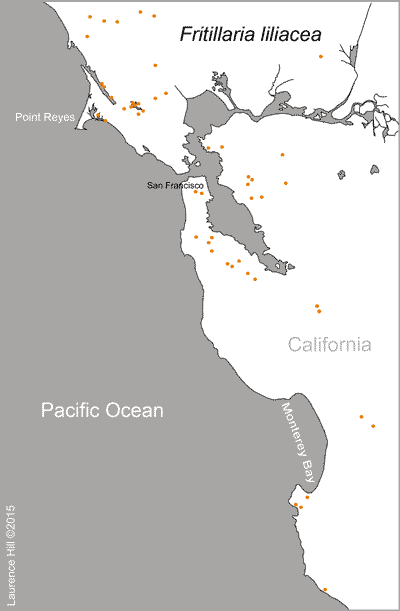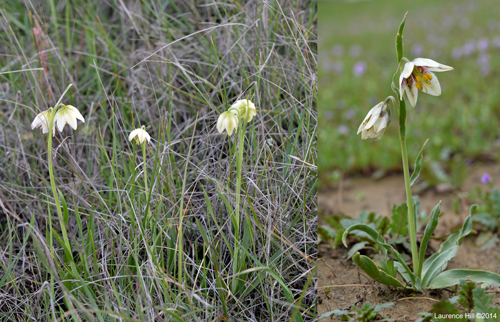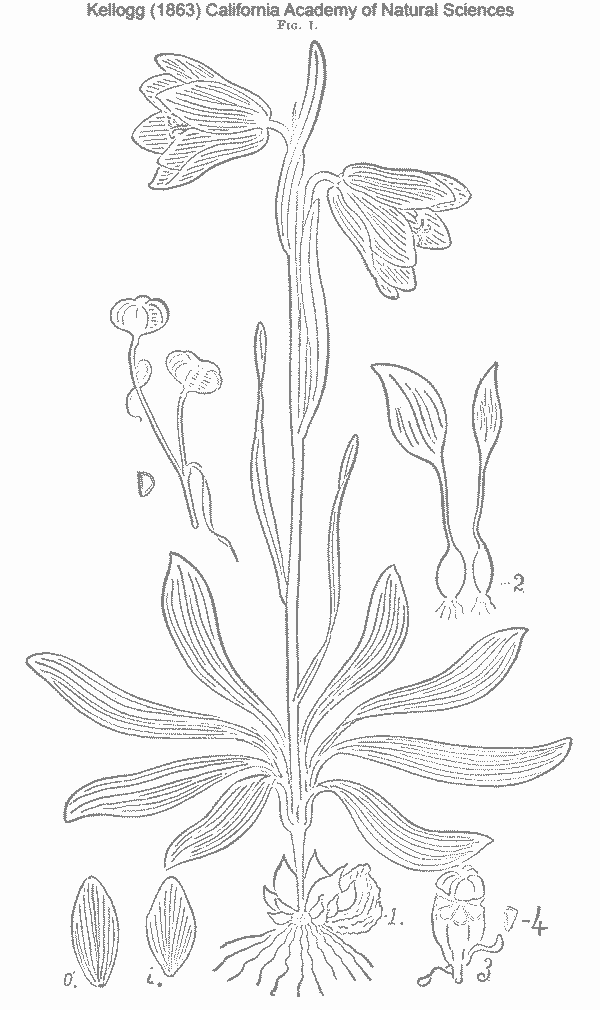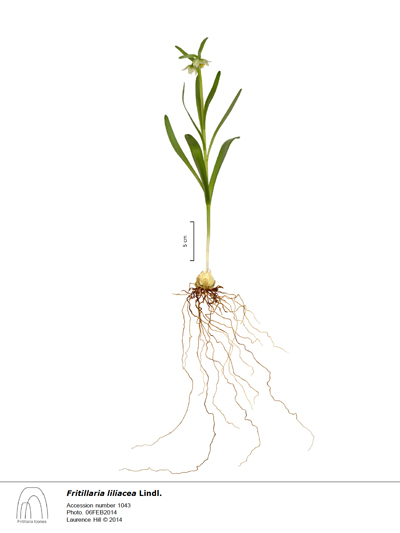Fritillaria liliacea
Unusual in the genus Fritillaria liliacea has a sweet scent, a sentiment expressed by its common name the fragrant fritillary. A member of the northern Californian grassland community it is found in isolated pockets throughout the San Francisco Bay Region. Its white flowers easily distinguish it from other closely related Fritillaria with similar stature and habitat like F. grayana (syn. F. roderickii) found further north and F. pluriflora found to the northeast. Its pre-vernal nature makes it vulnerable to grazing animals as it emerges before many other grassland species and damage to leaf-tips is often evident. In Marin Co. it grows together with the slightly more distantly related Fritillaria affinis a species more frequently found in open woodlands.
In the early nineteen century a period we call the Golden Age of Horticultural Exploration in the American West, David Douglas was sent by the Horticultural Society of London to collect in North America. With the sponsorship of the Hudson’s Bay Company he spent several years collecting along the Columbia River. From late December 1830 until mid-August 1833 he collected in California. Based in Monterey he made extensive trips along the El Camino Real staying at Franciscan missions from Santa Rosa in the north to Santa Barbara further south and inland to the Inner Coastal Ranges. Among his collections were three Fritillaria all collected in 1833. Later that year he was shipwrecked on the Fraser River in British Columbia where his field journals were lost. The following year, John Lindley, who as Assistant Secretary to the Horticultural Society of London, had overseen some of Douglas’ earlier studies, published a short account of these specimens in Edward’s Botanical Register. In describing F. liliacea Lindley noted, ‘a most remarkable plant with the habit of a Lily.’
On March 5, 1860 Albert Kellogg, one of the founders of the California Academy of Natural Sciences, writing in the journal of the Academy described a new genus Liliorhiza, an intermediate between Lilium and Fritillaria. His Liliorhiza lanceolata has the bulb of a lily but the style of a fritillary, also the flowers are not mottled, nodding and campanulate. Kellogg remarks that his new species is probably F. liliacea Lindley. The accompanying illustration shows the lily-like bulb structure with its distinctive small basal plate and fleshy imbricated scales. In 1874 Baker published the first classification of Fritillaria and among his ten subgenera F. liliacea was placed in the subgenus Liliorhiza (Kellogg) Baker so designating it the type. Both Watson (1879) and Rix (2001) followed Baker in including F. liliacea in subgenus Liliorhiza but Rix included all the North American Fritillaria. Molecular phylogenetic analysis by Rønsted et al. (2005) and more recently Ryan (2014) and Day et al. (2014) showed that subgenus Liliorhiza form a distinct clade with the Californian grassland species, including F. liliacea, forming a discrete cluster within the clade.
Liliorhiza lanceolata Kellogg
Fritillaria liliacea Lindley, Edwards’s Botanical Register 20: t. 1663. (1834).
Synonyms
Liliorhiza lanceolata Kellogg in Proceedings of the Californian Academy of Natural Sciences, 2: 46 (1863),
Fritillaria alba Kellogg in Proceedings of the Californian Academy of Natural Sciences 1: 46 (1855).
Vernacular names
fragrant fritillary, prairie bells
Description
Bulb 26 mm diam., base plate small 2-10 mm diam., composed of up to 14 fleshy imbricated scales attached at their base in a circle around the base plates, inner group large, outer group small.
Stem arising from the apex of the base plate, 12.5-36.5 cm tall. Leaves 2-20, mostly clustered near the base, opposite or alternate, ovate to linear, 3.5-12 cm long, 2-15 mm wide, Bract leaves one per flower, linear 2-6 cm long, 1-4 mm wide. Flowers nodding, odourless or faintly fragrant, 1-3(-8), white with green striations occasionally with purple near the base, perianth segments oblong-elliptic 10-16 mm long 5-6 mm wide, nectaries greenish, narrowly linear 1-2 mm, forming narrow band 1/2–2/3 tepal length. Style branched for 1/2 its length, often recurved. Filaments smooth. Anthers yellow. Capsule 15-20 mm long, stipitate, the back of each lobe slightly channelled and ridged.
Flowers: February – April. Fruit: May – June
Endemic to San Francisco Bay Region, open hills and fields near the coast
Chromosome number: 2n = 24 (Marin, Nicasio Reservoir, Roderick JEPS55705, Contra Costa, Richmond, nr. San Pablo Avenue, Beelte 14)
Type: California, D Douglas 1833 (GH, K)
Distribution
United States of America: California, Alameda, Contra Casta, Marin, Monterey, San Benito, San Francisco, San Mateo, Santa Clara, Solano, Sonoma Counties.

Including historic sites
Elevation
Near sea level to 230 m
Communities
Coastal Prairie, Valley Grassland, Vernal Pools. Chlorogalum pomeridianum (soap root), Dodecatheon clevelandii (Padre's shooting star), Dichelostemma capitatum (blue dicks), Erodium botrys (long-beaked stork's bill), Eschscholzia califonica (Californian poppy), Fritillaria affinis (checker-lily, mission bells), Leptosiphon androsaceus (false babystars), Limnanthes douglasiiI (poached egg plant, Douglas' meadowfoam), Lomatium utriculatum, (common lomatium), Lotus formosissimus (seaside bird's-foot trefoil), Lupinus bicolor (Lindley's annual lupine), Muilla maritime (sea muilla), Sidalcea malvaeflora (dwarf checkerbloom), Sisyrinchium bellum (common blue-eyed grass), Triphysaria eriantha (butter and eggs)
Habitat
Heavy clay soil, alluvium, typically on serpentine

Grasslands in San Mateo and Vernal Pools in Solano
Pollinator
Bombus vosnesenskii (Yellow-faced bumblebee)
Conservation
Fritillaria liliacea is considered rare and endangered in California; the California Native Plant Society ranking it as 1B.2. The San Francisco Bay region is densely populated and industrialized; even parks and preserves within this region have been subject to anthropological changes. Extant populations face ongoing pressures from drainage, grazing, non-native introductions, recreation and road construction. Populations are fragmented across its distribution and this will negatively impact its long-term survival.
Cultivation
First offered for sale by Carl Purdy in the 1890’s it has been grown by bulb specialist ever since. Most F. liliacea in cultivation today are probably from material collected from Nicasio Reservoir and this population has proved relatively easy to grow. However as F. liliacea is one of the first fritillaries to flower it may need the protection of a frost free greenhouse in some areas. Wild populations receive most of their precipitation between November and March, 65-200 mm, but bulbs are unlikely to be baked dry during summer dormancy. A degree of moisture is maintained by a combination of bulb depth (10-15 cm), shading by tall grasses and further moisture resulting from frequent fogs. In some areas soil moisture from fog exceeds annual precipitation.
References
Baker J G. 1874. Revision of genera and species of Tulipeae, Journal of the Linnaean Society 14: 211-310
Beetle D. 1944. A Monograph of the North American Species of Fritillaria, Madroño 7: 133-159.
Cave M. 1970. Chromosomes of California Liliaceae, University of California Publications 24: 26-32.
CalFlora
CNPS – California Native Plant Society, Sacramento, CA.
Day P D, Berger M, Hill L, Fay M F, Leitch A R, Leitch I J, Kelly L J. 2014. Evolutionary relationships in the medicinally important genus Fritillaria L. (Liliaceae). Molecular Phylogenetics and Evolution 80:11-19
Flora of North America – Liliaceae
Jepson Flora Project
Purdy C. 1893. Price List of Californian Bulbs. Ukiah, Mendocino Co., California, USA
Rix E M. 2001. Fritillaria. A Revised Classification. The Fritillaria Group of the Alpine Garden Society
Rønsted N, Law S, Thornton H, Fay M F, Chase M W. 2005. Molecular phylogenetic evidenc for the monophyly of the Fritillaria and Lilium (Liliaceae; Liliales) and the infrageneric classification of Fritillaria. Molecular Phylogenetics and Evolution 35: 509-527.
Ryan S P. 2014. Molecular Phylogeny and Character Evolution of Fritillaria Subgenus Liliorhiza (Liliaceae). Master of Science in Biology with a Concentration in Evolutionary Biology, San Diego State University
Santana D. O. 1984. Morphological and Anatomical Observations on the Bulbs and Tepals of Fritillaria (Liliaceae) Section Liliorhiza (Kellogg) Watson, Their Taxonomic Implications with a Synopsis and the Reproductive Biology of the Section. Ph.D. dissertation. University of California, Davis.
Watson S 1879. Revision of the North American Liliaceae. Proceedings of the American Academy of Arts and Science 14: 213-288
Laurence Hill ©2015
![]()




